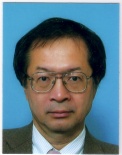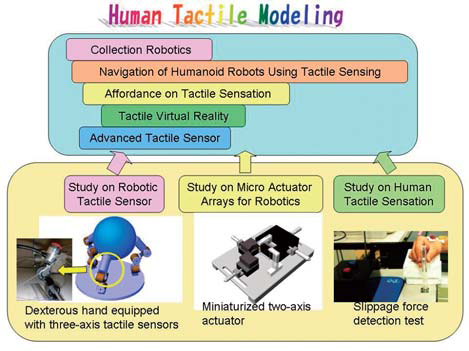Comprehensive List of Researchers "Information Knowledge"
Department of Complex Systems Science
- Name
- OHKA, Masahiro
- Group
- Complex Systems Computation Group
- Title
- Professor
- Degree
- Dr. of Engineering
- Research Field
- Intelligent robotics / Sensor and actuator system / Psychophysics on human tactile sensation

Current Research
Human Sensation Modeling towards Robotics
IntroductionRobots are highly complex systems comprised of several actuators. This complexity arises because both the characteristics of components and the relationships between components are nonlinear. Complex Science Computing provides appropriate solutions for integration of multi-sensor and actuator system such as data acquisition and recognition of environments, planning of navigation, and object handling. Observations on human sensations can be used to advance complex science computing toward robotics.
In our laboratory, human sensation mechanisms, especially for tactile perception, are being investigated, and mathematical models are being formulated on the basis of the mechanism. This work aims toward robotics and mechatronics, human-robot communication, virtual reality, human health, and medical applications. We study tactile sensors, micro-actuators for tactile displays, and psychophysics on tactile sensation as follows :
■ Collection robotics
■ Navigation of Humanoid Robots Using Tactile Sensing
■ Affordance on Tactile Sensation
■ Tactile Sensor using Stochastic Resonance
■ Tactile Virtual Reality
■ Tactile Sensor Based on Computerized Tomography
■ Human Tactile Sensation Mechanism
Human Tactile Sensation Mechanism
We have developed several apparatuses such as a fine step-height presentation device and a slippage force display. Furthermore, we have performed a series of psychophysical experiments to obtain subjective equalities and differential thresholds, which are important parameters for investigating human tactile sensation. Surface unevenness was acquired by Fast Adaptive Type I unit (FA I), and no difference was found between active and passive touch on discrimination of surface unevenness, while the unevenness amplitude felt by a human subject increased with an increase in the finger's sliding speed.
Tactile Sensor and Tactile Information Processing
Since not only pressure but also slippage force sensing determines dexterous robotic handing, we developed three-axis tactile sensors. We obtained Best Paper awards from the Japanese Society of Mechanical Engineers (JSME) in 1998 and 2002 and the Excellent Achievement award from Machine, Design and Tribology of JSME in 2004.
Using the three-axis tactile sensors, we made progress in tactile information processing. In our series of studies, we studied object recognition using artificial intelligence and Fuzzy inference to perform object recognition and control finger configuration according to the slippage caused on robotic fingers. We formulated equations of a neuron's activity caused by human tactile sensation and incorporated them into a robot equipped with the tactile sensor to recognize subtle unevenness on a surface.
Micro Actuator Array for Tactile Display
We developed several tactile displays according to our findings on human tactile sensations. Using the tactile displays, we are developing a tactile virtual reality system, which comprises a master hand having two sets of tactile displays with a 4-by-6 array of stimulus pins and an articulated manipulator, as part of the Japan Scientific Research of Priority Areas 438"Next-Generation Actuators Leading Breakthroughs"program. Since diameter discrimination and insertion precision of the virtual peg were increased by tactile information, tactile presentation was effective for the peg-in-hole task in the case of a relatively large clearance.
Future Work
In future work, we will advance the present study to multi-modal sensation of visual, auditory and tactile perceptions. Furthermore, we intend to develop a new computational method inspired by our studies.

Figure : Scheme of our study on tactile sensation modeling
Career
- 1986, Dr. Engineering, graduated from Graduate School of Engineering, Nagoya University
- 1986, Fuji Electric Research and Development Co., Ltd.
- 1992, Assistant Prof., Faculty of Engineering, Nagoya University
- 1993, Associate Prof., Shizuoka Institute of Science and Technology
- 2003, Associate Prof., Nagoya University.
Academic Societies
- JSME
- SICE
- RSJ
- Japan Ergonomics Society
- JSAEM
Publications
- Human Capability of Discriminating Relief-like 2D Figures in Tactile Displaying, Robotica, vol. 29-4, 2011
- Experiments on Stochastic Resonance Toward Human Mimetic Tactile Data Processing, International Journal of Social Robotics, vol.4, 2012
- Two-axial Piezoelectric Actuator Controller Using Multi-layer Artificial Neural Network Featuring Feedback Connection for Tactile Displays, Advanced Robotics Vol. 26 No. 3-4
- Flexible Active Touch Using 2.5D Display Generating Tactile and Force Sensations, Vol. 6, Issue 12, 2012








